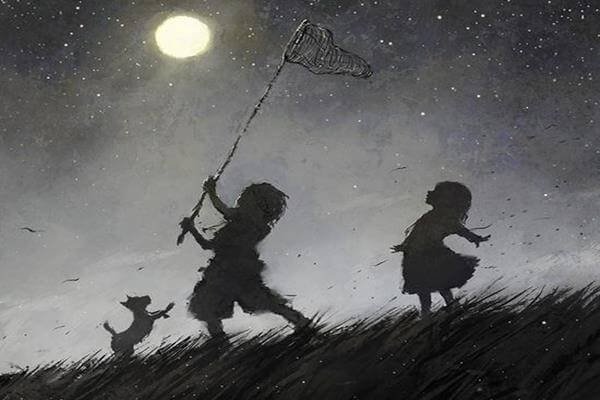Highly Sensitive Children


Written and verified by the psychologist Valeria Sabater
Much has been written about high sensitivity since Elaine N. Aron dug deeper into this personality trait in the 1990s. High sensitivity reflects someone who sees the world from a more intimate, sensitive, and personal point of view: from the heart. From the deepest depths within a person.
Since then, conferences have been organized, books, articles, and magazines have been published, there are groups on social media sites, and there has even been a movie made on the topic, bearing the title Sensitive. It is said that twenty percent of the population lives, feels, and acts in this way, and there is constant research being done on the best way to educate highly sensitive children.
A large number of these people arrive to adulthood feeling different. It is as if the daily whispers tuned a different melody for them, a sweeter, more beautiful one, but also a sadder one, one that only they know how to hear, that only they can intuit.
If it is only since the 90s that the world has started to understand that so-called “high sensitivity,” then it remains clear that there are millions of people who have gone through childhood, adolescence, and part of their adult life without knowing why they seem different from everyone else.
Nowadays and in light of the widespread information and impact that the topic of sensitivity has achieved, it is important that we be able to identify those children who have this sort of personality. Educating is not an easy task, but it is even more difficult to carry out with a child who from a very early age sees him or herself as being different. We want to give you some simple strategies for doing this.
Identifying highly sensitive children

For some parents, it can be difficult: “they complain a lot, they ask lots of questions.” However, in a classroom, a highly sensitive child draws no attention, causes no problems, and will have no chance of being tested to recognize their abilities, their intuition, or their sensitivity.
Those with high sensitivity do not fit in very well in modern societies. They do not like to compete, they do not like the immediacy or the mumbling of the masses. Highly sensitive children like to play with the stars, to meditate while listening to music, to spend time alone…
It is the job of their mothers and fathers to recognize the traits of high sensitivity in their children, too. We are not at all looking to correct their behaviors or “normalize” them. Definitely not. But we at least want to identify them so that we can help and understand them.
It is necessary to recognize them so that we can offer them guidelines, so that they know the reasons behind these inconsistencies, which they may feel in their day-to-day lives. For example, they will see that they are much more mature than their own friends and that the world sometimes seems out of tune and guided by extreme selfishness.

We have to guide, look after, communicate with, listen to, and convey to them our warmth and support… But before we can do that, it is important that we know how to identify highly sensitive children and the characteristics that best define them. Below, we will explain how to do this.
- High sensitivity also translates into physical sensitivity. Their pain tolerance is much lower: even their clothes rubbing against them can hurt the child. When they are babies, they tend to cry often upon hearing loud sounds.
- They are very mature children, and this can be seen in the profoundness of their questions.
- They intuitively know the mood of adults around them. They focus on their expressions and their gestures.
- This personal mature makes them feel different from their classmates.
- They are attentive to the details in their day-to-day lives.
- While being highly sensitive does not necessarily mean being introverted, they do enjoy being alone.
- They feel a passion for music, art, nature.
- They are interested in social problems.
- They feel hurt easily; any word or negative gesture deeply affects them.
3 educational pillars for highly sensitive children

Being different is a powerful weapon
We must not change a child into what they are not nor even try to “normalize” them. We have to accept their characteristics and make them see that feeling life with that intensity is not a misfortune, but a gift. The world has unique nuances that only they can see. Make them see that the world is a safe place. If they feel good with themselves, life will shine for them because they have light, because they are special and strong enough to face adversity.
Reinforce their self-esteem
Trust them, give them autonomy through positive reinforcement and validation. Show them that their abilities can allow them to do anything, that they have many qualities and potential. Develop their sense of self-effectiveness.
Prepare them for adversity
We know that they are only kids, but we are also aware that they notice many things that others do not. They feel more strongly the contempt, selfishness, silence, and rude gestures. This is something that we are going to have to work with each and every day, and we can do it through Emotional Intelligence.
TIf others do not act like me, it does not mean that they do not like or accept me. They feel things in another way, which is neither better nor worse. Just different. It is important that they learn to manage their frustration, sadness, and disappointment. Through their lives, they will feel more than one letdown, they will suffer, and all of those emotions will overwhelm them. It is important that they learn as soon as possible to manage these dimensions.
When highly sensitive children have discovered who they really are, balance will come into their daily lives. Then they will be authentic, mature, and happy people because they have lived life from the heart. Because they have had their own light.
Images courtesy of Mercer Mayer, Ida Rentoul, Melanie Delon
Much has been written about high sensitivity since Elaine N. Aron dug deeper into this personality trait in the 1990s. High sensitivity reflects someone who sees the world from a more intimate, sensitive, and personal point of view: from the heart. From the deepest depths within a person.
Since then, conferences have been organized, books, articles, and magazines have been published, there are groups on social media sites, and there has even been a movie made on the topic, bearing the title Sensitive. It is said that twenty percent of the population lives, feels, and acts in this way, and there is constant research being done on the best way to educate highly sensitive children.
A large number of these people arrive to adulthood feeling different. It is as if the daily whispers tuned a different melody for them, a sweeter, more beautiful one, but also a sadder one, one that only they know how to hear, that only they can intuit.
If it is only since the 90s that the world has started to understand that so-called “high sensitivity,” then it remains clear that there are millions of people who have gone through childhood, adolescence, and part of their adult life without knowing why they seem different from everyone else.
Nowadays and in light of the widespread information and impact that the topic of sensitivity has achieved, it is important that we be able to identify those children who have this sort of personality. Educating is not an easy task, but it is even more difficult to carry out with a child who from a very early age sees him or herself as being different. We want to give you some simple strategies for doing this.
Identifying highly sensitive children

For some parents, it can be difficult: “they complain a lot, they ask lots of questions.” However, in a classroom, a highly sensitive child draws no attention, causes no problems, and will have no chance of being tested to recognize their abilities, their intuition, or their sensitivity.
Those with high sensitivity do not fit in very well in modern societies. They do not like to compete, they do not like the immediacy or the mumbling of the masses. Highly sensitive children like to play with the stars, to meditate while listening to music, to spend time alone…
It is the job of their mothers and fathers to recognize the traits of high sensitivity in their children, too. We are not at all looking to correct their behaviors or “normalize” them. Definitely not. But we at least want to identify them so that we can help and understand them.
It is necessary to recognize them so that we can offer them guidelines, so that they know the reasons behind these inconsistencies, which they may feel in their day-to-day lives. For example, they will see that they are much more mature than their own friends and that the world sometimes seems out of tune and guided by extreme selfishness.

We have to guide, look after, communicate with, listen to, and convey to them our warmth and support… But before we can do that, it is important that we know how to identify highly sensitive children and the characteristics that best define them. Below, we will explain how to do this.
- High sensitivity also translates into physical sensitivity. Their pain tolerance is much lower: even their clothes rubbing against them can hurt the child. When they are babies, they tend to cry often upon hearing loud sounds.
- They are very mature children, and this can be seen in the profoundness of their questions.
- They intuitively know the mood of adults around them. They focus on their expressions and their gestures.
- This personal mature makes them feel different from their classmates.
- They are attentive to the details in their day-to-day lives.
- While being highly sensitive does not necessarily mean being introverted, they do enjoy being alone.
- They feel a passion for music, art, nature.
- They are interested in social problems.
- They feel hurt easily; any word or negative gesture deeply affects them.
3 educational pillars for highly sensitive children

Being different is a powerful weapon
We must not change a child into what they are not nor even try to “normalize” them. We have to accept their characteristics and make them see that feeling life with that intensity is not a misfortune, but a gift. The world has unique nuances that only they can see. Make them see that the world is a safe place. If they feel good with themselves, life will shine for them because they have light, because they are special and strong enough to face adversity.
Reinforce their self-esteem
Trust them, give them autonomy through positive reinforcement and validation. Show them that their abilities can allow them to do anything, that they have many qualities and potential. Develop their sense of self-effectiveness.
Prepare them for adversity
We know that they are only kids, but we are also aware that they notice many things that others do not. They feel more strongly the contempt, selfishness, silence, and rude gestures. This is something that we are going to have to work with each and every day, and we can do it through Emotional Intelligence.
TIf others do not act like me, it does not mean that they do not like or accept me. They feel things in another way, which is neither better nor worse. Just different. It is important that they learn to manage their frustration, sadness, and disappointment. Through their lives, they will feel more than one letdown, they will suffer, and all of those emotions will overwhelm them. It is important that they learn as soon as possible to manage these dimensions.
When highly sensitive children have discovered who they really are, balance will come into their daily lives. Then they will be authentic, mature, and happy people because they have lived life from the heart. Because they have had their own light.
Images courtesy of Mercer Mayer, Ida Rentoul, Melanie Delon
This text is provided for informational purposes only and does not replace consultation with a professional. If in doubt, consult your specialist.







